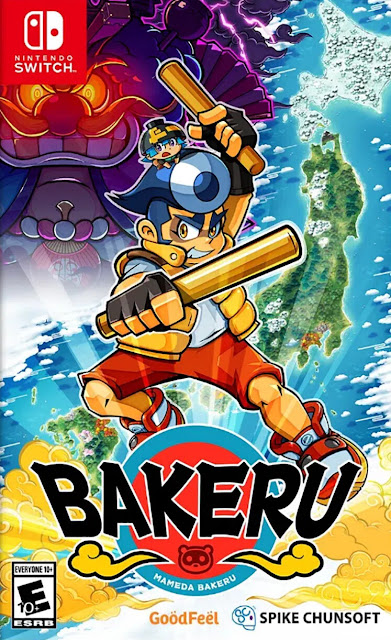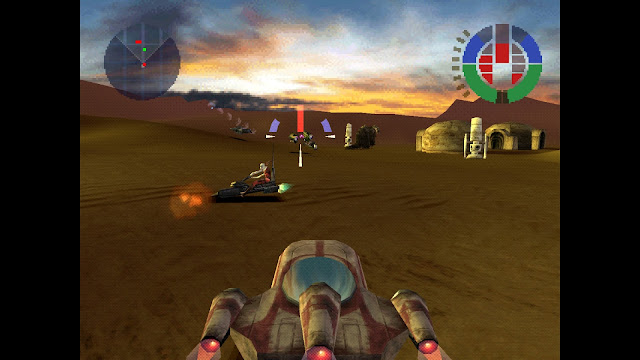This Sunday evening review closes this weekend out on a positive note. We do love a positive review here, don't we? That said, I shouldn't say any more, as I don't want to entirely spoil why BAKERU is such a good game! Instead, I'll let the actual SuperPhillip Central review do that!
Drumming up some big time fun
Otogi Katsugeki Mameda no Bakeru: Oracle Saitarou no Sainan!! is developer Good-Feel's latest independent game project. For those who might not be familiar with the developer, Good-Feel is best known for its work with Nintendo as a development partner, working on such games as Kirby's Epic Yarn, Wario Land: Shake It!, Yoshi's Woolly World, and most recently, Princess Peach: Showtime!
While those aforementioned games used Nintendo's help and support to make and publish them, Mameda no Bakeru was a self-published game at least in Japan, which begged the question if anyone would pick up the proverbial slack to publish it outside of the Land of the Rising Sun. For someone like myself who loves platformers and feels the gaming world needs more of the 3D variety at any point in time, I eagerly anticipated any news towards a proper localization.
Well, needless to say, the game finally was brought over to the West in due time (specifically, almost a year wait) and in North America by none other than Spike Chunsoft. Now simply titled BAKERU in the West, the game saw its release last year and most recently, a physical Nintendo Switch version two months ago. Was the wait of myself and others (there were more than dozens of us, I'm sure!) really worth it?
A little girl from the Issun Clan named Sun stumbles upon a tanuki boy named Bakeru while being chased by the evil Oracle Saitaro's troops. After being saved by Bakeru, Sun relays information about the Oracle, expressing that Saitaro's scheme of turning all of Japan into a giant dance party is underway. In order to stop this, Sun suggests that together, her and Bakeru should head to and get the aid from various legendary Japanese heroes to thwart Oracle Saitaro's master plan. What follows is a charming, cute, and crazy (in the best ways) adventure that takes Bakeru and Sun all across and over fairytale Japan.
 |
Oracle Saitaro's troops are all over Japan causing a ruckus,
so it's up to Bakeru and Sun to crash their party! |
BAKERU is a 3D platformer with lots of heart and lots of drumming, too. Bakeru's main form of attacking is with his two taiko drumsticks, one in his left hand and one in his right, using the left and right bumpers respectively. Both can be used together or alternated to strike enemies or one or both bumpers can be held down to unleash more powerful attacks. The drumsticks aren't just for warding off and beating down foes, either. They're used for drumming on gears and other mechanisms to spin platforms, open doors, and much more.
 |
| Here, Bakeru strikes these gears with his drumsticks in order to move this green platform along its attached rail. |
Early on in his journey, Bakeru learns various Henge powers, four to be exact across the adventure. Each one possesses unique abilities and has contextual uses for when they're best used. One allows Bakeru to shrink to fun-size, Sun's size, entering into small alcoves, doors, and passageways that he otherwise wouldn't be able to fit into. Another is an absolute powerhouse of a Henge ability, offering immense strength in exchange for the Henge meter depleting at a super swift pace. The final two Henge powers grant fishing lines that can rapidly attacks foes with light strikes from faraway, while the other allows Bakeru to skate around while firing off pellets from a pair of guns. Switching between forms is as simple as holding down the shoulder button and selecting from the menu with the corresponding face button for the Henge power you want. Returning to normal Bakeru form is easy peasy--a tap of both shoulder buttons at once.
 |
| In this Henge form, Bakeru wants his enemies to talk to his hands, because the drum does not understand! |
One of the most impressive aspects to me of BAKERU is that the game is constantly throwing new gameplay ideas and mechanics at the player, all the while spreading itself across over 60 levels. There is of course your standard 3D action-platforming where Bakeru runs, jumps, and drums through areas, beating down enemies, evading obstacles, and exploring the relatively lengthy levels for collectibles. More on those in a little bit. However, there are also races, literal dogfights in the air (if only because your vessel is a block-shaped pupper of a dog), and even giant mecha robot boss battles, apart from the typical on-foot-as-Bakeru boss fights.
 |
| These epic mecha robot battles play out similarly to boxing matches--complete with knockout counts! |
Each level contains eight collectibles players can opt to find, and these are rather rewarding. Not just because they encourage exploration and are sometimes in some truly tricky spots, but also because they provide information and trivia to the player. Five of these collectibles are Scoop's trivia. Scoop is character, also a member of the Issun clan that when found in levels, provides interesting trivia and imparts his knowledge onto the player. From learning aspects of Japanese geography and culture, to learning the difference between "clouds and fog" or better yet, where farts go (yes, really), Scoop is fountain of fun information. Other than the five "scoops" from Scoop in each level, there are three Souvenirs based on the areas and prefectures of Japan that each level in BAKERU are based off.
 |
| Don't worry, Bakeru. That's no piece of poop--that's none other than Scoop! |
The platforming stages within BAKERU have a wide amount of variety all in themselves. There are verdant forests, bright beaches, lush gardens, bustling cities, chaotic construction sites, tall mountains, fiery volcanoes, snowy slopes, underwater amusement parks, gigantic bridges, traditional Japanese temples, and so much more within the game to discover and platform through.
The amount of enemies in BAKERU is impressive, as well, offering lots of unique foes to take on, some requiring skillful dodging, evading, or better yet, timing in order to parry their attacks to leave them wide open to an offensive onslaught of Bakeru's own. No doubt a skill check early on within the game are the enemies dressed in armor and wielding kendo sticks. Trying to take them on as Bakeru with but simple drumstick strikes is a fool's errand. They'll simply block each and every attempt to attack them. And then there's when their eyes light up bright red, ready to make their move, dash forth, and strike Bakeru. These enemies gave me quite a bit of trouble starting off in the game when they were introduced, but as Bakeru learns additional Henge powers, they go down with relative ease as more and more tools and tricks are learned.
 |
| Bakeru hasn't exactly gone fishin', but he does "cast" some lines of pain onto these projectile-firing foes! |
One of these tools is that of helpful items from the tanuki shopkeeper Uriko, who frequents levels at checkpoints throughout the game. For an amount of gold found readily throughout levels, not only does she sell food that can instantly heal Bakeru when needed, but passive, temporary buffs like increased speed or attack, as well as items that can be saved for a rainy day (or in BAKERU's case, a difficult boss or challenging level) like an item that instantly replenishes Bakeru's Henge energy, or even a shield that guards against any and all attacks for 30 seconds. There are also premium items like crackers in the shape of hearts that permanently boost Bakeru's maximum health. Truly helpful in the long term.
While BAKERU is by no means the most arduous adventure around, it does have some challenging points to it, whether when Bakeru faces more-fiendish boss battles, trickier platforming trials, or even searching for hidden Tanuki disguised as objects in some stages, where only feint occasional movement or a tanuki stamp reveals their locations. That said, it's overall a relatively breezy experience if you're a seasoned gamer, but at the same time, BAKERU as a game is not something you can simply sleepwalk through and expect to easily complete it. Finding all 200+ Scoops, all 150+ Souvenirs, all 20-something hidden Tanuki, and securing all the game's achievements will certainly take some effort. For me, this process to 100% the game took about 20 hours.
 |
In most sections of BAKERU, you'll have fully free 360 degree
camera movement available to you. ...Not exactly here, though. |
BAKERU is a gorgeous game, and depending on the platform you play it on, it will be more or less a technically sound experience. While the lesser-powered Nintendo Switch does sometimes simply struggle to hold a steady framerate--this is most apparent in the hot springs level--it does an admirable job of running well. The Steam version is understandably more capable and consistent in performance, seldom showing signs of FPS drops. Both versions I did not encounter much in the way of bugs nor glitches, which really impressed me, as when a game has over 60 levels, I would think something would have to give somewhere. This is thankfully not the case with BAKERU. The game features voice acting, though this is Japanese-only, which works for the game since it's set in Japan and stays authentic.
 |
| Time for some construction destruction, courtesy of Bakeru! |
If you're looking for another charming and well-designed game from Good-Feel, well, you certainly have one with BAKERU. The developer once again shows with BAKERU that it doesn't necessarily need Nintendo's supervision in order to create a fantastic game. That's not to discredit either Good-Feel or Nintendo here, of course, as together, they do create some awesome gaming experiences. Between BAKERU's colorful and engaging levels to explore--each based off a Japanese prefecture--a multitude of secrets housed within these said levels, an astonishing amount of gameplay variety, entertaining boss battles, cute and charming humor, and gorgeous graphics, BAKERU marches to the beat of its own drum and is a great, original game for doing so.
[SPC Says: A-]

















